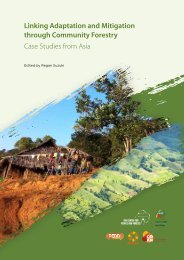Desktop Study on - Regional Climate Change Adaptation ...
Desktop Study on - Regional Climate Change Adaptation ...
Desktop Study on - Regional Climate Change Adaptation ...
You also want an ePaper? Increase the reach of your titles
YUMPU automatically turns print PDFs into web optimized ePapers that Google loves.
<str<strong>on</strong>g>Desktop</str<strong>on</strong>g> <str<strong>on</strong>g>Study</str<strong>on</strong>g><br />
priority, especially in the next 20-30 years. In<br />
additi<strong>on</strong>, mitigati<strong>on</strong> measures should also be taken<br />
into account and the policy opti<strong>on</strong>s that could be<br />
explored may be either regulatory or ec<strong>on</strong>omic in<br />
nature with instruments such as trading permits,<br />
carb<strong>on</strong> tax and tax rebates. Thus, the challenge lies<br />
in balancing adaptati<strong>on</strong> and mitigati<strong>on</strong> measures.<br />
At Present there is no specific policy for every<br />
ec<strong>on</strong>omic sector to address the Global Warming-<br />
<strong>Climate</strong> <strong>Change</strong> Threat as it affects the individual<br />
sectors (productivity). At best is to adhere to best<br />
practices to minimize envir<strong>on</strong>mental degradati<strong>on</strong><br />
and natural resources exploitati<strong>on</strong> as strategized in<br />
objectives of the 9th Malaysia Plan and the Nati<strong>on</strong>al<br />
Envir<strong>on</strong>mental Policy (Salleh, 2007).<br />
Regarding water gaps, informati<strong>on</strong> that is needed<br />
to forecast water availability includes improved<br />
estimati<strong>on</strong> of regi<strong>on</strong>al populati<strong>on</strong> growth, land use<br />
changes, and likely shifts in water demand as a result<br />
of demographic and ec<strong>on</strong>omic changes. In additi<strong>on</strong>,<br />
improved informati<strong>on</strong> <strong>on</strong> the likely range of climatic<br />
c<strong>on</strong>diti<strong>on</strong>s is an important prerequisite for a better<br />
formulati<strong>on</strong> of adaptive and abatement measures<br />
(MOSTE, 2000).<br />
Although it can be said that Malaysia has sufficient<br />
water resources to meet populati<strong>on</strong> needs, there<br />
are some water-related problems, related with<br />
managing water effectively to achieve objectives. In<br />
some river basins, there is already the problem of<br />
water shortage especially during periods of prol<strong>on</strong>g<br />
droughts, and c<strong>on</strong>versely, the problem of excessive<br />
water and floods during the wet seas<strong>on</strong>. The most<br />
challenging issue is to coordinate activity from<br />
various government agencies and private sector in<br />
managing the watershed. River basin should be the<br />
basic planning unit but now, rivers are managed <strong>on</strong><br />
political or administrative boundaries, which do not<br />
provide an overall engineering soluti<strong>on</strong> (Husaini,<br />
2007).<br />
Reducti<strong>on</strong> of flood and drought losses has to involve<br />
a number of government agencies and often the<br />
private sector. For example, reservoirs for irrigati<strong>on</strong>,<br />
water supply and flood mitigati<strong>on</strong> have c<strong>on</strong>flicting<br />
operati<strong>on</strong>al rules. Development of comm<strong>on</strong><br />
objectives and definiti<strong>on</strong> of clear roles for each of<br />
the stakeholders as well as close cooperati<strong>on</strong> and<br />
understanding am<strong>on</strong>g is needed to be efficient and<br />
successful. Also, the implementati<strong>on</strong> and formulati<strong>on</strong><br />
of flood and drought management acti<strong>on</strong> plans<br />
cannot be d<strong>on</strong>e without cooperative integrati<strong>on</strong> of<br />
all stakeholders. (Husaini, 2007).<br />
The MSMA is <strong>on</strong>ly a guideline, and DID has<br />
no legal authority to enforce the said manual<br />
as mandatory procedure to local authorities,<br />
developers, c<strong>on</strong>tractors etc. Although at present<br />
proposed development programs have been<br />
based <strong>on</strong> those master plans, few problems rise<br />
during the implementati<strong>on</strong>: local authorities are<br />
facing insufficient technical expertise and financial<br />
limitati<strong>on</strong> to provide adequate maintenance of<br />
c<strong>on</strong>structed drainage systems; developers c<strong>on</strong>sider<br />
the utilizati<strong>on</strong> of the manual as an increase to the<br />
project’s cost; c<strong>on</strong>tractors find that maintenance of<br />
erosi<strong>on</strong> c<strong>on</strong>trols and sediment traps are not comm<strong>on</strong><br />
works to them; c<strong>on</strong>sultants are still very weak <strong>on</strong><br />
the c<strong>on</strong>cept of urban stormwater design. Without<br />
widespread applicati<strong>on</strong> of the manual guidelines,<br />
effective flood and drought management for urban<br />
areas will c<strong>on</strong>tinue to be hindered (Husaini, 2007).<br />
In the Ninth Malaysia Plan is missing a full chapter<br />
<strong>on</strong> sustainable water resources management in the<br />
country, that includes an holistic and integrated<br />
approach <strong>on</strong> water resources management (IWRM<br />
and IRBM); how ec<strong>on</strong>omic development, unless<br />
properly planned and executed, can exacerbate<br />
polluti<strong>on</strong>, floods, forest fires, develop extreme<br />
climate events following climate change; and<br />
how better integrated, managed, m<strong>on</strong>itored and<br />
enforcements of infrastructure development can<br />
provide not <strong>on</strong>ly better returns but provide better<br />
managed envir<strong>on</strong>ment, including, water supply,<br />
flood and polluti<strong>on</strong> abatement in those very areas.<br />
The Nati<strong>on</strong>al Water Resources <str<strong>on</strong>g>Study</str<strong>on</strong>g> (for Peninsular<br />
Malaysia) Mac 2000 and the Master Plan for the<br />
Development of Water Resources in Peninsular<br />
Malaysia (2000-2050) did not take into account<br />
potential change of hydrologic regime and water<br />
resources due to climate change (Zakaria and<br />
Jamalluddin, 2007).<br />
The NHRIM recalls that <strong>Climate</strong> <strong>Change</strong> projecti<strong>on</strong><br />
have to be studied further and translated into<br />
how it will impact the social and ec<strong>on</strong>omic sectors<br />
(agriculture, forestry, bio-diversity, coastal<br />
resources, water resources, public health & energy) of<br />
Malaysia, that expected changes in water availability<br />
by year 2050 require a review of current water<br />
resources plans in the various sub-sectors and states<br />
of Peninsular Malaysia, that further downscaling<br />
studies using other GCM’s (ECHAM5- MPI Germany,<br />
MRI-CGCM2.3.2- MRI Japan, CM2.1-GFDL USA,<br />
CGCM3.1- Canada) are needed and also further<br />
research <strong>on</strong> the future hydrologic regime (rainfall/<br />
streamflow characteristics at finer temporal and<br />
spatial timescales) (Zakaria and Jamalluddin, 2007).<br />
152

















